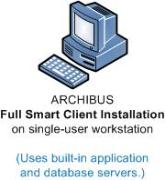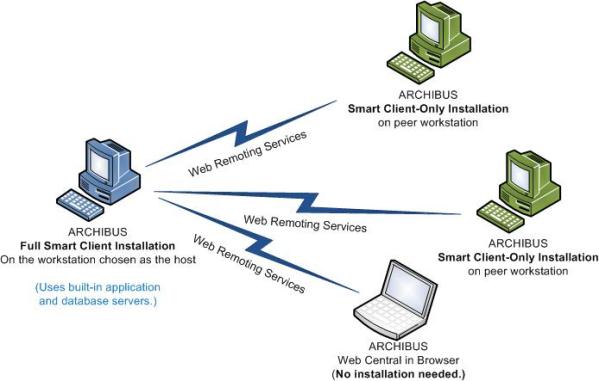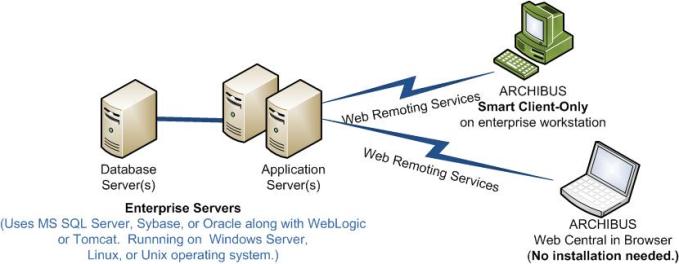
You can install the ARCHIBUS software:
Each deployment is listed, diagrammed, and briefly described below.
In the single-user deployment, the user runs the full ARCHIBUS installation. They can then run Web Central, the Smart Client, and the Smart Client Extensions for AutoCAD and Revit.

The workgroup deployment is as follows:

For more information, see Workgroup Deployment Details.
In the enterprise deployment, the system administrator loads the database (e.g. Oracle, Microsoft SQL Server) on a database server and the application server (e.g. Tomcat, WebLogic) on an application server. Enterprise users can access Web Central using their Web browser. Remote users can also run the Smart Client-Only installation to install the Smart Client and the Extensions, and then log into ARCHIBUS running on the application server.

The Smart Client Extensions for AutoCAD and Revit, along with the Smart Client DWG Editor, enable CAD and BIM users to work at distant regional or multi-national offices and still connect to the Web Central servers at headquarters – eliminating countless emails, extracts, and duplications of data to keep remote sites, remote offices, architects, contractors, and outsourced CAD service providers in synch. You can even use servers hosted in the cloud to anchor CAD and BIM efforts – a particularly useful deployment configuration for working with AEC firms which are often CAD-savvy but that do not have in-house database and building lifecycle experience.
These products work from the same protocols and centralized security as Web Central does, meaning that you need no new IT infrastructure to provide feature-rich, high-volume, graphical editing and data access.
These products let you access enterprise real estate information even during the design stage. These features speed commissioning of buildings – the new information you need to commission and run your building doesn’t need to be “imported” or “synchronized” with your lifecycle management data because ARCHIBUS made certain it was entered to the correct standards in the first place.
The extension products simplify deployments for CAD and BIM specialists, architects, and contractors. These users simply need to load the remote Smart Client component, set their CAD Application preference, and start their copy of AutoCAD or Revit. The ARCHIBUS extensions load automatically and present the Sign In dialog.
Tip: Signing in to ARCHIBUS. If the URL of the ARCHIBUS host server doesn’t appear in the “Server” control, type in the name of the host just as you would when entering this URL into a Web Browser (such as, http://hostserver:8080/archibus). Enter your user name, password, and then sign in. The program will remember this URL so you need not retype it.
The Extension products are mixed-mode .Net programs and can run in either 32-bit or 64-bit AutoCAD or Revit.
The CAD Application preference (accessed from Smart Client's Preferences command) lists all of the CAD and BIM programs installed on your workstation, such as AutoCAD 2010, AutoCAD 2011, Revit 2011, and the ARCHIBUS DWG Editor. When you select your CAD application, the Smart Client configures Revit, AutoCAD, and the Smart Client DWG Editor to load the Extensions when they start.
Tip: Listed CAD Applications. If a supported application does not appear in the CAD Application preference's drop-down list, the Smart Client program cannot find it in the registry because the application either is not installed or is not correctly installed.